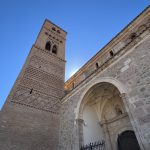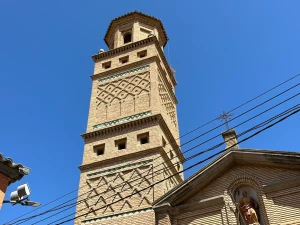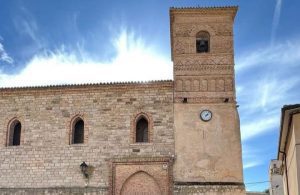
Circular from
the country school
The “Circular from the rural school” project is a cooperation project between rural development groups led by the Asociación Territorio Mudéjar.
The following have participated in the project: ADRI Calatayud-Aranda, ADRI Jiloca-Gallocanta, FEDIVALCA -Valdejalón and Campo de Cariñena-, ASOMO Tarazona and el Moncayo, CEDEMAR -Bajo Aragón Caspe and Ribera Baja del Ebro-, ADRAE -Ribera Alta del Ebro- and ADEFO Cinco Villas.
The objective is to develop educational materials around the Mudejar identity of the towns, placing rural schools and the educational community of the towns as the center of the project.
Based on the work developed, for almost three years, the students of fifteen schools have designed a walk through their town in which we can learn about the main points of interest and their connection with the Mudejar culture.

Cervera de la Cañada
This walk shows us the work of the pupils of the CRA Río Ribota in Cervera de la Cañada.
Cervera de la Cañada is located between the Sierra de Armantes mountain range and the Ribota river valley. On the ruins of an ancient castle, in the highest part of the town, stands one of the jewels of Aragonese Mudejar architecture: the church of Santa Tecla or Nuestra Señora de la Asunción. It was built by one of the two most representative master builders of the Aragonese Middle Ages: Mahoma Ramí. The monument dialogues with the town’s urban planning, which is developed on the slopes of the hill on which the church is located.

1. History of the town
The oldest part of Cervera la de Cañada can be found in the remains of its castle, which were later used for the construction of the church. A circular tower of ashlar stone remains, which probably formed part of a fortified complex.
This point is linked to the didactic activity 1

2. World heritage
The church of Santa Tecla is a fortress church adapted to the place where it was built. It was declared a UNESCO World Heritage Site in 2001 for its unique style in the world, as well as for its magnificent conservation.
This point is linked to learning activity 5.

3. Construction materials
The Mudejars were particularly skilled in the construction of buildings of unique technical characteristics and beauty. This church was built by Mahoma Ramí, Pope Luna’s favourite master builder, although this church was commissioned by the local council and lordship (de la Cierva). The materials used by the Mudejars are materials that can be found in the surrounding area, such as clay and plaster.
This point is linked to the didactic activity 3

4. Coexistence of cultures
After the arrival of the Christians in Calatayud in 1120, we can say that the Mudejar period began. At this time, Christians, Muslims and Jews coexisted and lived segmented within the same localities.
This point is linked to the didactic activity 2

5. Reminiscences
After the arrival of the Christians in Calatayud in 1120, we can say that the Mudejar period began. At this time, Christians, Muslims and Jews coexisted and lived segmented within the same localities.
This point is linked to the didactic activity 7

6. Importance of agriculture
After the arrival of the Christians in Calatayud in 1120, we can say that the Mudejar period began. At this time, Christians, Muslims and Jews coexisted and lived segmented within the same localities.
This point is linked to the didactic activity 6









